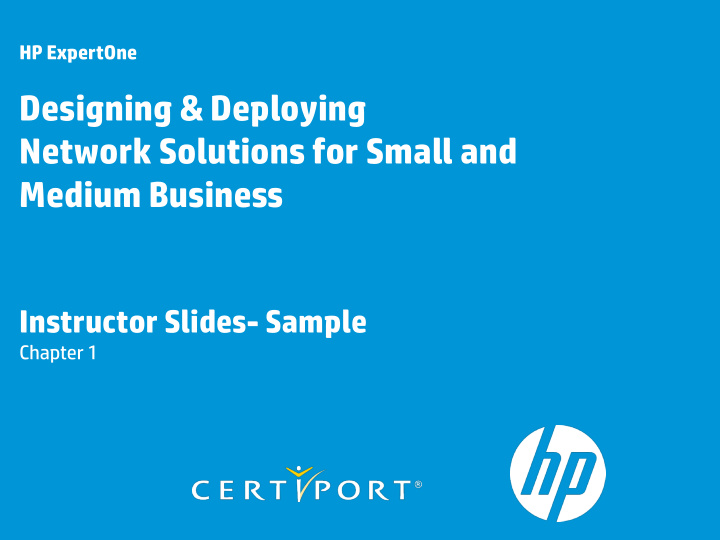



HP ExpertOne Designing & Deploying Network Solutions for Small and Medium Business Instructor Slides- Sample Chapter 1
Designing & Deploying Network Solutions for Small and Medium Business
Chapter 1 Network Fundamentals 3
Objectives • Describe the OSI seven-layer model. • Compare and contrast the OSI and TCP/IP models. • Explain the purpose and use of various addressing methods. • Identify common Ethernet technologies. • Identify common wireless technologies. • Explain basic security concepts. 4
OSI Model 5
OSI Layer 1 Physical Layer • Functionality provided: Transmission media o Connector o Signal strengths o Data encoding o Data synchronization o Transmission technique o 6
OSI Layer 2 Data Link Layer • Functionality provided: Link control o Traffic control o • Sequencing • Acknowledgement • Delimiting • Error correction Access management o • The MAC address is defined at the Data Link layer. 7
MAC Address 8
OSI Layer 3 Network Layer • Functionality provided: Network address o Node address o Traffic routing o Fragmentation/reassembly o 9
Network Address 10
OSI Layer 4 Transport Layer • Functionality provided: Segmentation o Acknowledgement o Traffic control o Multiplexing o 11
OSI Layer 5 Session Layer • Functionality provided: Establishing sessions o Managing/maintaining sessions o Terminating sessions o 12
OSI Layer 6 Presentation Layer • Functionality provided: Character translation o • ASCII • EBCDIC Conversion o Compression o Encryption o 13
OSI Layer 7 Application Layer • Functionality provided: Remote file and printer access o Resource sharing o Communications between o processes Electronic messaging and o email Directory services o Virtual devices and virtual o communications 14
TCP/IP Model 15
TCP/IP Model Network Interface Layer • Supports: Implementation of OSI Physical and Data Link layers. o Hosts identified by MAC address. o A wide range of low-level protocols. o • Does not support: Sequencing o Acknowledgement o 16
TCP/IP Model Internet Layer • Responsible for: network addressing o host addressing o routing o • Internet Protocol version 4 (IPv4) 192.168.10.42 • Internet Protocol version 6 (IPv6) fe80::d46f:5f6c:bff1:30db 17
ARP Command 18
TCP/IP Model Transport Layer • Provides datagram services for Application layer protocols. • TCP Connection-oriented protocol o Establishes connection between hosts o Provides sequencing and acknowledgement o Recovers lost packets through retransmission o • UDP Connectionless protocol o One-to-one or one-to-many transmissions o 19
TCP/IP Model Application Layer • Information exchange protocols • Management protocols Managing and resolving host names with IP addresses o Maintaining and sharing route information between routers o Automatically providing network configuration information for host o computers 20
Ethernet • Standard defines: Transmission media and connector types o Cable segment lengths o Transmission signals (strength and format) o Frame format o Network access method o 21
Network Adapter 22
Current Ethernet Standards Name Data rate Standard Note 10BaseT 10 Mbps 802.3i Requires two twisted pairs 100BaseT 100 Mbps 802.3u Requires two twisted pairs 1000BaseT 1 Gbps 802.3ab Requires four twisted pairs 10GBaseT 10 Gbps 802.3an Requires four twisted pairs 23
Straight-through Cable 24
For the complete version, please contact your local salesperson. www.certiport.com/sales 25
Recommend
More recommend